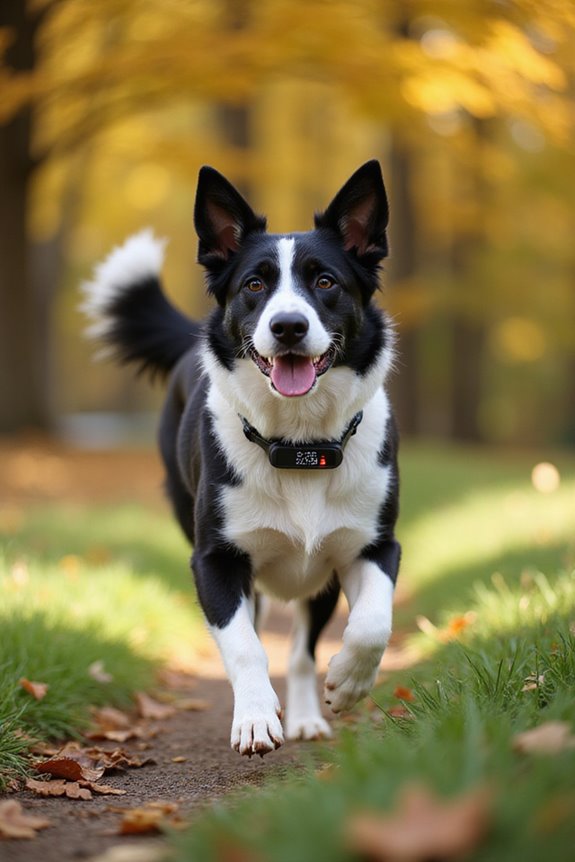Activity monitors are crucial for tracking dog fitness, providing detailed insights into several health metrics. They monitor physical activity levels and steps, ensuring tailored exercise plans based on breed and size. These monitors also evaluate sleep patterns, offering data on sleep quality and rest disturbances. Additionally, they give health insights by detecting behavioral changes and stress responses. Finally, they track caloric intake and nutrition, fundamental for managing a dog’s weight. Further exploration reveals how these features enhance overall canine health.
Key Takeaways
- Activity monitors track step counts accurately during walks and play to ensure dogs achieve their fitness goals.
- Customizable activity benchmarks engage dogs and help owners monitor fitness progress effectively.
- Insight into sleep patterns identifies rest quality, which is vital for a dog’s overall health and recovery.
- Real-time GPS tracking and Safe Zones enhance safety, allowing dogs to exercise freely while ensuring owners can monitor their location.
- Calorie and nutrition tracking helps manage weight by integrating activity data with dietary needs for balanced health.
Tracking Physical Activity and Steps
Tracking a dog’s physical activity and steps is essential for maintaining their overall health, particularly as different breeds have varying exercise needs. By utilizing step tracking features of devices like the Fi Series 3 Smart Collar, I can establish customizable activity benchmarks tailored to my dog’s breed and size. This guarantees I’m setting realistic goals, preventing frustration for both my dog and me.
Key benefits include:
- Accurate step counts during walks and play, motivating my pup to stay active.
- Tailored goals enhance engagement and promote appropriate fitness levels.
- Daily benchmarks allow me to monitor my dog’s progress effectively.
Understanding these aspects helps me foster a healthier lifestyle for my dog, aligning their activity with their specific needs and behaviors.
Monitoring Sleep and Rest Patterns

Although many dog owners may not realize it, monitoring sleep and rest patterns is as essential to a dog’s health as tracking their physical activity. Dogs go through multiple sleep stages, which include light sleep and deep, restorative phases. Each cycle lasts about 10-15 minutes and showcases changes in breathing and movements. By using activity monitors, I can assess rest quality and identify disruptions or restlessness that might indicate discomfort or anxiety.
These modern devices capture extensive sleep data, offering insights beyond simple observation. They help me understand my dog’s sleep duration, restlessness, and overall well-being, paving the way for proactive health management and personalized care plans, ensuring my furry friend enjoys a happier, healthier life.
Health and Behavioral Insights

Gaining insights into a dog’s health and behavior has become increasingly feasible with the use of activity monitors, which provide valuable data that transcends physical activity alone. Through monitoring fluctuations in activity levels, I can identify subtle behavioral changes, such as increased restlessness or decreased engagement, which may indicate anxiety or discomfort.
These devices can help in anxiety detection, correlating physiological responses, like heart rate variability, with activity trends. For instance:
- A spike in activity combined with elevated heart rates might signal stress.
- Sudden decreases in physical engagement could point toward mood disorders.
GPS Location and Safety Monitoring
As I explore the range of capabilities offered by modern dog activity monitors, GPS location and safety monitoring emerges as a fundamental aspect to take into account. These devices provide real-time location tracking, using cellular networks to deliver location accuracy via smartphone apps.
Key features include:
- Safe Zones: You can set geofences, receiving immediate alerts if your dog wanders outside pre-defined areas, enhancing overall safety.
- Additional Safety Features: Many models offer sound signals and lights for locating pets in low visibility.
- Durability: Waterproof designs guarantee functionality in various weather conditions.
This integration of location tracking and innovative safety features fosters both freedom for your dog and peace of mind for you, allowing for a more enjoyable outdoor experience.
Calorie and Nutrition Tracking

Understanding calorie and nutrition tracking for dogs is essential if you want to properly manage your pet’s weight and health. Activity monitors can provide insights into caloric balance, but accuracy varies. Predicted daily caloric intake can range from 52% to 140% of actual needs. Here are key points to evaluate:
- Personalization: Inputting your dog’s breed, age, and weight helps improve the accuracy of caloric calculations, leading to better dietary adjustments.
- Integration: Pairing activity data with diet logs can reveal discrepancies in feeding and activity levels, helping maintain proper caloric balance.
- Behavior Tracking: Advanced monitors categorize activity types, refining calorie burn estimates and supporting dietary planning.
Design, Durability, and User Features
Design, durability, and user features are critical aspects to contemplate when selecting an activity monitor for your dog.
Design Considerations
- Compact and lightweight, typically ranging from 22-37mm in diameter and weighing approximately 10-22g, ensuring comfort.
- Waterproof ratings, such as IP67 or IP68, safeguard against swimming and mud, perfect for adventurous dogs.
- Collars attach easily, minimizing discomfort and the risk of loss.
- User-friendly apps provide access to detailed metrics on activity, sleep, and behavior.
Durability Features
- Battery life spans from 15 days to 6 months, reducing the need for frequent recharging.
- Robust casing withstands impact, catering to energetic breeds.
- Warranty periods, often spanning two years, reflect manufacturer reliability and commitment to quality.
Personalized Fitness Goals
When you prioritize your dog’s fitness, personalized fitness goals become an integral component of their overall health strategy. Setting personalized activity targets is vital because it considers your dog’s specific breed, age, and health status.
Benefits of Personalized Fitness Goals:
- Customized Daily Activity: Trackers can establish tailored benchmarks for steps, active minutes, and calories burned.
- Progress Monitoring: Continuous tracking allows for real-time adjustments to goals.
- Data-Driven Decisions: These insights guarantee you avoid under- or over-exercising your dog.
- Motivation: Personalized goals encourage consistent exercise habits.
Competition and Social Engagement
Engaging in competition and social interaction through activity monitors can considerably enhance both a dog’s fitness journey and the bond between owner and pet. These devices foster community engagement by allowing owners to compare their dog’s activity levels with others. Features like leaderboards and group challenges stimulate competitive motivation, encouraging consistent exercise routines.
Moreover, activity monitor apps offer social features, enabling owners to participate in local walking groups or virtual challenges. This not only strengthens relationships among dog owners but also helps combat social isolation. By sharing achievements, we build accountability and inspire one another. In this enriching environment, both dogs and owners benefit, promoting healthier lifestyles while deepening their emotional connection through shared goals and mutual support.
Understanding Your Dog’s Overall Well-being
Understanding a dog’s overall well-being goes beyond mere physical activity; it encompasses several interconnected aspects of health. As guardians of our beloved pets, we must take into account their emotional well-being alongside their physical fitness. For example, monitoring behavioral changes can provide insights into their mental state.
Key factors to take into account include:
- Activity Levels: Using monitors to track daily movement helps gauge fitness.
- Vital Signs: Heart rate and respiration rates indicate stress and overall health.
- Sleep Quality: Evaluating sleep patterns can reveal issues affecting recovery.
- Environmental Context: GPS data guarantees outdoor safety and evaluates comfort levels.
Frequently Asked Questions
How Do I Choose the Best Activity Monitor for My Dog?
When I’m choosing a dog monitor, I look for features like activity tracking accuracy, step counting, and comfort. It’s essential for me to find a device that truly understands my pup’s unique needs and lifestyle.
Can Activity Monitors Be Used for Dogs With Health Issues?
You know, just like those old-timey stethoscopes helped doctors, modern activity monitors serve as essential health monitoring tools. With activity tracking, I can spot health issues in my dog before they become serious. It’s truly invaluable.
What Is the Typical Battery Life of a Dog Activity Monitor?
I’ve noticed that battery longevity varies among dog activity monitors. Typically, they need charging every two weeks to three months, depending on features. I always check the battery status to guarantee it’s ready for our adventures!
Are There Mobile Apps That Complement Dog Activity Monitors?
Absolutely, there are mobile tracking apps that enhance our experience. They help set fitness goals, track activity levels, and guarantee our furry friends stay healthy. I love using them to stay connected with my dog’s well-being!
Do These Monitors Work for All Dog Breeds and Sizes?
I’ve found that activity monitors can vary in effectiveness across breeds and sizes. Breed compatibility and size considerations really matter; some devices excel with larger dogs while struggling to track smaller, more delicate movements accurately.



